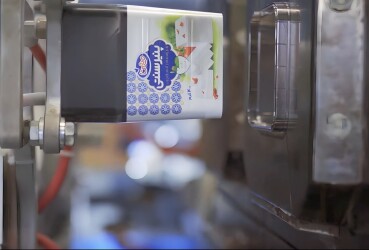Understanding in-mold labeling
In-mold labeling (IML) is a labeling method in which a pre-printed decorative film is placed into a mold before the plastic container is shaped into that mold. Plastic pellets or resin are heated and placed into the mold where it merges with the label to create a single product.
In-mold labeling is most commonly used for thin-walled disposable items like consumer packaging that have a shorter shelf life. Companies in food, personal care, household and cosmetic industries often use IML to brand their packaging.
Plastic containers with in-mold labeling are manufactured through two methods: injection molding and blow molding.
Types of in-mold labeling processes
Injection molding (Pictured above) - In injecting molding, the design label is placed into the mold before fusing together with the container. After the plastic pellets are heated, the resin is injected into the mold where it seamlessly combines with the label.
Blow molding - Blow molding is similar to glass blowing. Like injection molding, the label is inserted into the mold before it is combined with the plastic. However, instead of injecting plastic into the mold, it is blown in using an air stream. Once expanded into the desired shape, the label melds to the container.
Benefits of in-mold labeling
1) Design Quality
In-mold labeling provides high resolution colors and images for labels. IML is compatible with a wide range of colors and can be displayed on both sides of the package. In-mold labeling is a powerful platform for enhancing graphic effects, enabling business owners the flexibility to respond to creative design ideas using flat, curved, or 3D-formed graphics.
The label is fused to the plastic giving the in-mold container a clean, smooth, integrated and unlabeled look as opposed to post-mold labeling (PML). This label remains intact throughout its life and is highly tamper-proof unless the container is cut open.
2) Durability
The water resistance of in-mold labeling makes it a reliable labeling option that can withstand both humid environments and extreme temperature fluctuations (freezing / cooling conditions). In contrast to pressure sensitive labeling, IML is a permanent design method with excellent impact and scratch resistance because it fuses permanently to the container.
A container with in-mold labeling has the potential to be impervious to abrasion and chemicals depending on the hard coatings used to generate the manufactured goods.
3) Environment-friendly
Traditional methods of pressure sensitive labeling require adhesives that are not accepted by every recycling plant. Because both the container and the label are combined without the exterior glue, plastic products with IML can be eco-friendly and fully recyclable depending on the type of plastic resin used to manufacture the product.
Since in-mold labeling containers are completely recyclable, they are eligible to become PCR products which can help decrease carbon footprints and leave a positive impact on the environment.
4) Cost-effective
For mass production, in-mold labeling containers take less time to manufacture because it is produced and decorated in one step to form a single product. In comparison to PML, in-mold labeling is typically more cost-efficient because it is without the expense of time, labor and floor space; IML also reduces inventory like post-mold paper labels and adhesives.
Is in-mold labeling right for you?
While IML has many benefits, in some scenarios conventional labeling may be the best option for you depending on your needs. Here are some factors to consider if IML is the best labeling option for your needs:
High minimum order quantity
Minimum order quantities are typically higher for in-mold labeling compared to traditional labeling methods due to the set-up cost associated with precise positioning and intricate design. For considerable businesses, in-mold labeling is a valuable method because the cost per container is lower in mass production quantities.
Increased lead times
Because IML requires specific mold design and construction for accurate placement and reliability, the time between initiation and completion of the production process can be longer in comparison to other labeling methods.
In-Mold Labeling - What is IML


